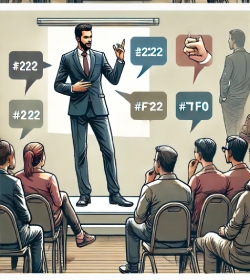The best presentation or performance is not just the delivery of content but the engagement of your audience. If you're a musician, speaker, actor, or performer, creating a strong connection with your audience can mean the difference between an experience that is completely forgettable and an experience that leaves an impactful, lasting impression. Best practices for engaging audience effectively.

The initial part of engaging your audience is getting to know them. Identify their interests, demographics, expectations, etc., and frame your content accordingly. For instance, maybe a younger crowd likes a high-energy, interactive session, while your corporate audience prefers something more structured and refined.
Your tone and delivery can be adjusted to suit the food preferences of the audience as well. If there is a more informal crowd you are talking to, a conversational tone is better. On the other hand, formal presentations call for a more formal approach.
Avoid overly technical jargon unless your audience is familiar with the subject matter. Speak in terms they understand, making it easy for them to follow along and connect with your message.
Less engagement in an opening and first impressions. Start with a quote, a fun fact, a question or an anecdote.
Confidence on stage comes from standing tall, making eye contact, and using open gestures to keep your audience invested and confident that you deserve to be there.
That means dressing for the occasion. Whether casual, business formal or performance attire, ensure your clothing matches your audience's expectations and the message you're trying to project.
Asking questions engages the audience by challenging them to offer their thoughts and contribute. Mix this one up with rhetorical questions and direct questions — keep that attention.
More people engage with content when it elicits a response from the audience. Bring volunteers on stage, conduct live polls, or have them get moving!
This is especially true in musical and theatrical performances. A dynamic of give and take helps sustain energy and keeps the audience attentive.
Stories resonate deeply with audiences. Structure your performance or presentation around a narrative that connects emotionally with listeners.
Sharing your own experiences makes your message more relatable. Authenticity fosters a stronger connection with the audience.
Descriptions that engage the senses—such as vivid imagery, sound effects, or movement—enhance storytelling and make the experience more immersive.

Eye contact fosters a personal connection. Instead of scanning the room aimlessly, focus on different individuals to create intimacy and maintain engagement.
Avoid standing stiffly in one place. Walk around naturally, using movement to emphasize key points and energize your performance.
Hand gestures add emphasis and help convey emotions. Ensure they feel natural and complement your message rather than distracting from it.
A monotonous delivery loses the audience's interest. Use fluctuations in pitch, speed, and volume to maintain excitement and emphasize important moments.
Speaking too fast may overwhelm listeners, while speaking too slowly can cause them to lose their attention. Find a natural rhythm that keeps them engaged.
Strategic pauses allow key moments to sink in and build anticipation, making your message more memorable.
While enthusiasm is essential, too much energy without control can come across as chaotic. Learn to balance your excitement with steady, deliberate movements and vocal modulation.
Slides, videos, and images should be visually appealing and relevant and enhance your presentation rather than clutter it.
For performers, music and sound effects can evoke emotions and enhance the overall experience. Even in presentations, background music can set the tone effectively.
Check that your microphone, sound system, and visuals function properly before the event. Poor audio or visuals can break the audience engagement and cause frustration.
Seamless integration of visuals, sound, and movement creates a captivating experience. Rehearse transitions to ensure smooth execution without technical hiccups.
The closing moments of your performance or presentation should be powerful and memorable. Summarize key takeaways and leave the audience with something thought-provoking.
Encourage your audience to take the next step—whether it's applying what they learned, following your work, or participating in an upcoming event.
Consider ending with a quote, an impactful image, or an emotionally charged statement that resonates with the audience long after your performance.
Engagement doesn't have to end when the performance is over. Provide ways for your audience to stay connected, whether through social media, newsletters, or exclusive content.
Audience interaction is vital for any show or presentation. Learning your crowd, using interactive strategies, storytelling, and controlling energy would enable you to hold your audience and leave a dent. Use these best practices to take your performances to the next level and maximize the experience for everyone involved.
It will take some practice to figure out what really amps your audience up. Still, by consistently ribbing them and adapting your delivery, you can create a stronger, more visceral connection each time you address an audience.